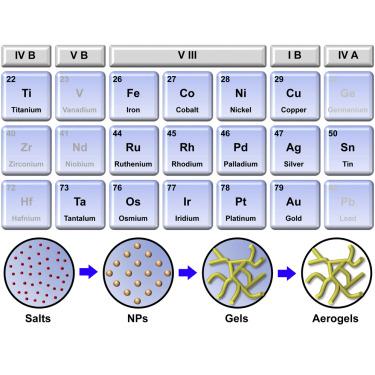Matter ( IF 17.3 ) Pub Date : 2021-01-06 , DOI: 10.1016/j.matt.2020.10.001 Xiaodi Jiang , Ran Du , René Hübner , Yue Hu , Alexander Eychmüller

|
Armed with merits of the metals (e.g., electrical conductivity, catalytic activity, and plasmonic properties) and aerogels (e.g., monolithic structure, porous network, and large specific surface area), metal aerogels (MAs) have stood out as a new class of porous materials in the last decade. With unparalleled potential in electrocatalysis, plasmonics, and sensing, they are envisaged to revolutionize the energy- and detection-related application fields. However, MA development is severely retarded by the lack of a sufficient material basis. Suffering from the ambiguous understanding of formation mechanisms, big challenges remain for tailoring MAs for task-specific applications. By surveying state-of-the-art developments, this review strives to summarize design principles and arouse interest in broad scientific communities. Moreover, critical challenges and opportunities are highlighted to provide a research roadmap for this young yet promising field.
中文翻译:

3D金属气凝胶路线图:材料设计和应用尝试
凭借金属(例如,电导率,催化活性和等离激元性质)和气凝胶(例如,整体结构,多孔网络和较大的比表面积)的优点,金属气凝胶(MA)成为一类新兴的近十年来多孔材料。设想它们在电催化,等离子体激元和传感领域具有无与伦比的潜力,将彻底改变与能源和检测相关的应用领域。但是,由于缺乏足够的物质基础,MA的发展受到严重阻碍。由于对形成机制的理解不明确,为任务特定应用定制MA仍然面临着巨大挑战。通过综述最新发展,本综述致力于总结设计原理并引起广泛科学界的兴趣。此外,






























 京公网安备 11010802027423号
京公网安备 11010802027423号